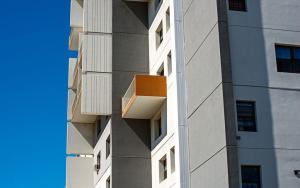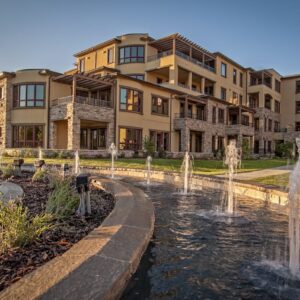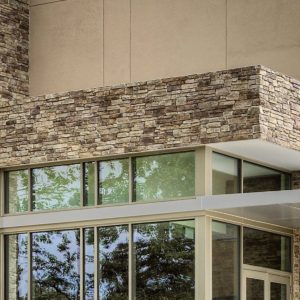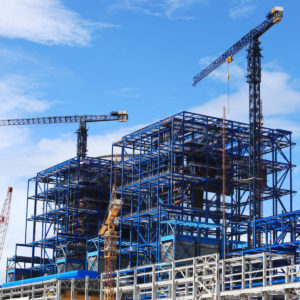For over 50 years, builders have used exterior insulation finish systems (EIFS) on structures ranging from hi-rise commercial to multi-family buildings. EIFS cladding provides:
- Fully engineered wall system that includes air and water-resistive barrier and continuous insulation
- Energy efficiency
- Fire-resistance
- A low-maintenance structure
EIFS also offers versatile, attractive, and sophisticated exterior finishes. Periodically, EIFS finishes require cleaning to remove dirt, algae, or mildew that accumulates on the surface or recoating to refresh the look of the cladding or change the color. Choosing the suitable coating will determine how often you need to maintain the EIFS.
Benefits of EIFS Painting (Recoating)
Properly painting EIFS can add several significant benefits to a building’s exterior
- Aesthetic Versatility: You can paint EIFS with endless colors and textures.
- Longevity: EIFS paint creates a long-lasting, new, and fresh appearance with lasting weather- and wind-proofing protection.
- Flexibility: EIFS elastomeric paint coating can expand and contract seven times its original size in a flat sheen appearance.
- Easy Maintenance: You can quickly repair tiny cracks from settling, and they do not peel, like paint on wood.
Eight Tips for a Successful EIFS Painting Project
As with any cladding, EIFS also needs routine maintenance. Choosing the right coating will determine the maintenance schedule. Fresh paint will improve the structure’s curb appeal, increase resale value, and attract clients and tenants. In addition, due to the complexity and importance of the proper application of EIFS paint, we strongly recommend hiring an experienced, qualified EIFS paint professional.
1. Gather Your Tools and Materials Before Starting
Tools
- Caulk gun
- Extension ladder
- Paint brushes
- Paint roller cage
- Pressure washer or garden hose
- Roller covers (thick-napped)
Materials
- Acrylic exterior caulk
- Polyurethane exterior caulk
- Acrylic latex exterior paint, flat finish
2. Inspect the Building
- Check the EIFS for stress cracks (due to settling), particularly around the windows and doors.
- Check the gutter system and repair it if needed. An ineffective gutter system can lead to discoloration or deterioration of the EIFS.
- Make sure the sprinkler system doesn’t directly hit the EIFS.
3. Clean and Gently Pressure Wash the Building
Apply a product or use a recommended cleaning method for EIFS, then gently rinse off with a pressure washer (on its lowest setting) or a garden hose. Applying too much water pressure to EIFS can harm the finish or allow water to infiltrate. NOTE: Mix cleaners and detergents according to the manufacturer’s directions.
Safe products and methods for cleaning EIFS:
- Specialized EIFS cleaner
- Light detergent like dish soap
- Water and vinegar
- Diluted bleach
- Borax
- Pressure washer on low setting
- Soft-bristled brush
Products and methods not safe for cleaning EIFS:
- Heavy duty paint
- Paint or rust-removing solvent not meant for EIFS
- Sandblasting
- Pressure washer on high settings
- Steam
- Do not use abrasive cleaning techniques or caustic chemicals, which will permanently damage the finish
4. Repair the EIFS
For cracks larger than 7 millimeters, fill the voids with an elastomeric exterior caulk to create a texture similar to the rest of the surface. In addition, repair and seal with caulk around the doors, windows, and other projections.
5. Only Use Paints Specifically Made for EIFS
Successfully painting an EIFS wall requires the right coating or paint, like those available from Sto Architectural Coatings: traditional Acrylic, Elastomeric, Sto iQ Technology, and Specialty Aesthetic coatings. In addition, select flat, low-sheen colors for EIFS, and avoid high-gloss.
StoColor® Acryl Plus and Flat Coatings
Acrylic-based, high-performing StoColor® Acryl Plus (satin sheen) and StoColor® Acryl Flat coating for vertical above-grade applications come in any color from the Sto Color palette. Both coatings offer unique features that enhance their durability and lifespan when used over prepared concrete, masonry, plaster/stucco and EIFS.
StoColor® Acryl Plus provides excellent protection against the following:
- Wind-driven rain
- Severe sun, heat, humidity, salt, dirt, and rain
- Salts and environmental pollutants.
- Blistering and mold and mildew growth due to its high permeability
- Fade resistance
StoColor® Acryl Flat offers protection against the following:
- Protects against severe weather conditions: sun, salt, heat, humidity, rain, and dirt
- Vapor permeable resists mold and blisters caused by moisture
- CO2 diffusion resistance, which protects against steel corrosion
Sto Elastomeric Coatings
The high-elongation properties of Sto Elastomeric coatings make it an excellent choice for EIFS painting. Sto Elastomeric coatings:
- Cover hairline cracked caused by thermal changes in the substrate
- Resist wind-driven rain and water absorption on vertical surfaces
- Provide superior UV resistance
- Curtail mold and mildew growth
Sto iQ Technology
Nature-inspired Sto iQ Technology Coatings offer superior functionality and durability and will keep the façade clean, dry, and bright to reduce maintenance.
- StoColor® Lotusan®, with Lotus-Effect® technology, offers super hydrophobic and self cleaning properties for EIFS wall systems.
- StoColor® Dryonic®, with its quick drying properties, provides optimum resistance to algae, fungi, and weathering, protecting an EIFS’s buildings’ color, material, and original design for the lifetime of the structures.
Specialty Aesthetic
Specialty Aesthetic coatings create unique aesthetics to elevate a building’s design: StoColor® Metallic, StoColor Wood Stain, StoTique (antique look), and StoColor® Texture.
6. Applying Paint to EIFS
Applying Sto Architectural Coatings for new or recoating wall surfaces will preserve your building’s value by providing a breathable, durable, and attractive layer of protection against environmental elements. Application may vary by coatings or substrate condition.
- Apply only to:
- Sound and clean, dry, properly prepared, frost-free surfaces.
- At ambient and surface temperatures of 40°F (4°C) and rising, and below 100°F (38°C).
- Do not apply:
- Over damp surfaces or during rain, hail, or snow events or if rain, hail, or snow is imminent.
- At a surface temperature of less than 5°F (2.8°C) above the ambient dew point temperature
- At below grades or in areas subjected to hydrostatic pressure, water immersion, ponding, or puddling
- on wood or metal surfaces
- Prepare or prime EIFS substrate according to Sto primer product bulletin.
- Apply in two uniform coats by brush, roller, or with proper spray equipment.
- Apply coating in a continuous application – do not overcoat. Work away from a wet edge or architectural break to eliminate cold joints. Back roll open texture surfaces, like concrete masonry.
- Allow sufficient time for drying between coats.
Additional Tips for Successful EIFS Painting:
- Avoid heavy-duty paints that may seal the EIFS and create a vapor barrier that will trap moisture in the building envelope. These paints may also contain powerful solvents that can erode EIFS.
- Never add color additives to the EIFS stucco mixture because future repairs due to small cracks from settling will not match the exterior color. Painting the exterior of EIFS after installation will ensure uniform color when repairing the exterior.
- Colors with light reflectance values (LRV) of 20 or greater are generally recommended for EIFS systems that do not incorporate mineral wool insulation.
7. Clean Up
Immediately clean tools and equipment with water after use to avoid material drying, which will require mechanical removal.
8. Maintain EIFS
Maintaining and adequately cleaning EIFS will increase its lifespan and beauty for years. Sto recommends annual inspections of the EIFS to look for cracks, discoloration, or moisture issues and to touch up as needed.

Sto Corp. products helped revive the former Ocean Village, now the Arverne View, by improving its energy efficiency and curb appeal:
Sto Products:
- StoColor® Acryl Plus and StoColor® Silcolastic (on its balcony)
- StoTherm® ci Lotusan®: Exterior continuous insulation wall system
- StoLit® Lotusan®: Tintable ultra-hydrophobic textured wall finish with superior self-cleaning properties
- StoGuard®: Fluid applied air and water-resistive barrier
Elastomeric, silicone-enhanced StoColor® Silcolastic decorative coating waterproofs, resists dirt and mildew, and bridges hairline cracks.
You can use it to protect vertical EIFS, concrete, stucco, masonry, or previously acrylic-coated smooth/textured surfaces. Its roller and spray application creates a smooth finish in various colors, making it easy to improve a substrate’s appearance quickly. However, Sto recommends avoiding dark-colored coatings over using foam plastic insulation. Instead, select finish colors with a lightness value of 20 or greater.
Benefits of StoColor® Silcolastic
- Silicone-enhanced StoColor® Silcolastic resists dirt and mildew growth better than standard acrylic elastomeric coatings.
- Vapor permeability allows the substrate to breathe naturally, which resists the blistering caused by trapped vapor.
- Weatherproofing features include:
- Repels water
- Provides hot and cool temperature stability
- Protects against ultraviolet light
- Easy application increases job-site productivity.
- Low VOC contributes to a safe job site and protects the environment.
- Reusable tools clean up with only water, so there is no need for hazardous solvents.
- Available in Sto’s standard colors and custom colors to match existing project colors.
Note: The substrate’s pH, texture, absorption, and desired aesthetic look may require an application of StoPrime Sand primer over the substrate.
StoColor® Lastic
Elastomeric, acrylic-based StoColor® Lastic decorative coating waterproofs, and bridges hairline cracks. You can use it to protect vertical EIFS, concrete, stucco, masonry, or previously acrylic-coated smooth/textured surfaces.
Benefits of StoColor® Lastic:
- Acrylic base provides excellent adhesion, weather-resistant, and color stability.
- Roller and spray application creates a smooth finish in various colors, making it easy to improve a substrate’s appearance quickly.
- Flexibility bridges hairline cracks.
- Weatherproofing features include:
- Repels water
- Provides hot and cool temperature stability
- Protects against ultraviolet light
- Vapor permeability allows the substrate to breathe naturally, which resists blistering caused by trapped vapor.
- Easy application increases job-site productivity.
- Low VOC contributes to a safe job site and protects the environment.
Tip for a Successful EIFS Paint Project – Use Sto Architectural Coatings
Sto Architectural coatings will help you successfully paint your EIFS building to significantly improve and freshen its aesthetics, increase its resale value, attract customers and tenants, and protect the integrity of the building. However, the project’s success depends on properly preparing the substrate and following the manufacturer’s instructions.
For more on the do’s and don’ts of EIFS painting, contact a Sto professional today at (800) 221-2397.


